(完整)小学六年级上册英语语法
- 格式:doc
- 大小:103.88 KB
- 文档页数:15
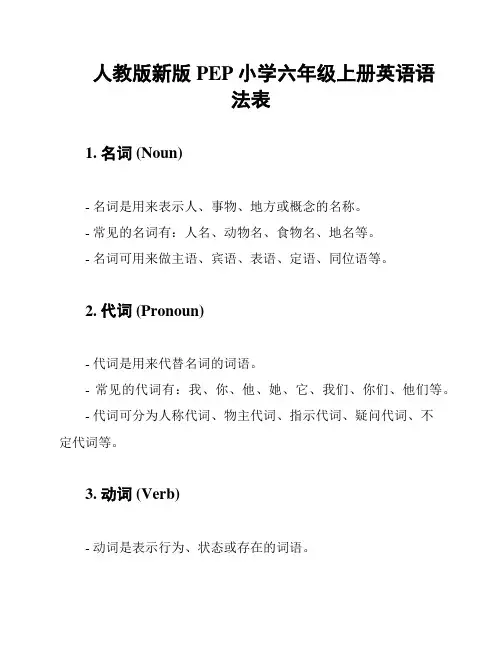
人教版新版PEP小学六年级上册英语语法表1. 名词 (Noun)- 名词是用来表示人、事物、地方或概念的名称。
- 常见的名词有:人名、动物名、食物名、地名等。
- 名词可用来做主语、宾语、表语、定语、同位语等。
2. 代词 (Pronoun)- 代词是用来代替名词的词语。
- 常见的代词有:我、你、他、她、它、我们、你们、他们等。
- 代词可分为人称代词、物主代词、指示代词、疑问代词、不定代词等。
3. 动词 (Verb)- 动词是表示行为、状态或存在的词语。
- 动词分为实义动词和虚义动词,实义动词可以独立构成句子的谓语。
- 动词还可以根据时态、语态、语气等形式进行变化。
4. 形容词 (Adjective)- 形容词是用来描述名词的特点和性质的词语。
- 形容词通常位于名词前面作定语。
- 形容词可以比较级和最高级,并可根据名词的性质进行变化。
5. 副词 (Adverb)- 副词是用来修饰动词、形容词和其他副词的词语。
- 副词可以回答疑问词how、when、where等问题的词语。
- 副词可用来修饰句子和句子的成分。
6. 冠词 (Article)- 冠词是表示名词特指与泛指的词语。
- 冠词分为定冠词和不定冠词,定冠词包括"the",不定冠词包括"a"和"an"。
- 冠词用来限定名词的范围和数量。
7. 介词 (Preposition)- 介词是用来表示名词与其他词之间关系的词语。
- 常见的介词有:in、on、at、above、below等。
- 介词通常位于名词或代词的前面。
8. 连词 (Conjunction)- 连词是用来连接句子、词语或词组的词语。
- 常见的连词有:and、but、or、so等。
- 连词可以连接并列关系、选择关系、原因和结果关系等。
9. 数词 (Numeral)- 数词是用来表示数量的词语。
- 数词分为基数词和序数词,基数词用来表示数量的多少,序数词用来表示次序和顺序。
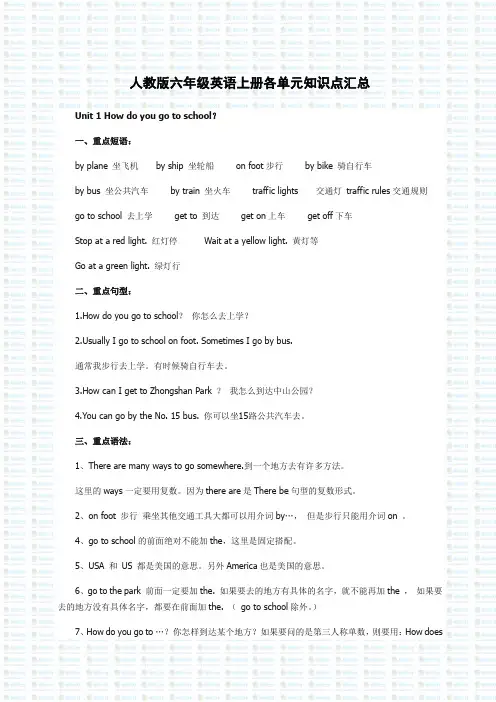
人教版六年级英语上册各单元知识点汇总Unit 1 How do you go to school?一、重点短语:by plane 坐飞机by ship 坐轮船on foot步行by bike 骑自行车by bus 坐公共汽车by train 坐火车traffic lights 交通灯traffic rules交通规则go to school 去上学get to 到达get on上车get off下车Stop at a red light. 红灯停Wait at a yellow light. 黄灯等Go at a green light. 绿灯行二、重点句型:1.How do you go to school?你怎么去上学?ually I go to school on foot. Sometimes I go by bus.通常我步行去上学。
有时候骑自行车去。
3.How can I get to Zhongshan Park ?我怎么到达中山公园?4.You can go by the No. 15 bus. 你可以坐15路公共汽车去。
三、重点语法:1、There are many ways to go somewhere.到一个地方去有许多方法。
这里的ways一定要用复数。
因为there are是There be句型的复数形式。
2、on foot 步行乘坐其他交通工具大都可以用介词by…,但是步行只能用介词on 。
4、go to school的前面绝对不能加the,这里是固定搭配。
5、USA 和US 都是美国的意思。
另外America也是美国的意思。
6、go to the park 前面一定要加the. 如果要去的地方有具体的名字,就不能再加the ,如果要去的地方没有具体名字,都要在前面加the. (go to school除外。
)7、How do you go to …?你怎样到达某个地方?如果要问的是第三人称单数,则要用:How doeshe/she…go to …?8、反义词:get on(上车)---get off(下车)near(近的)—far(远的)fast(快的)—slow(慢的)because(因为)—why(为什么)same(相同的)—different(不同的)9、近义词:see you---goodbye sure---certainly---of course10、频度副词:always 总是,一直usually 通常often经常sometimes 有时候never 从来不Unit 2 Where is the science museum?一、重点短语:library 图书馆post office 邮局hospital医院cinema 电影院bookstore书店science museum科学博物馆turn left向左转turn right 向右转go straight 直行north北south南east东west西next to靠近、与……。
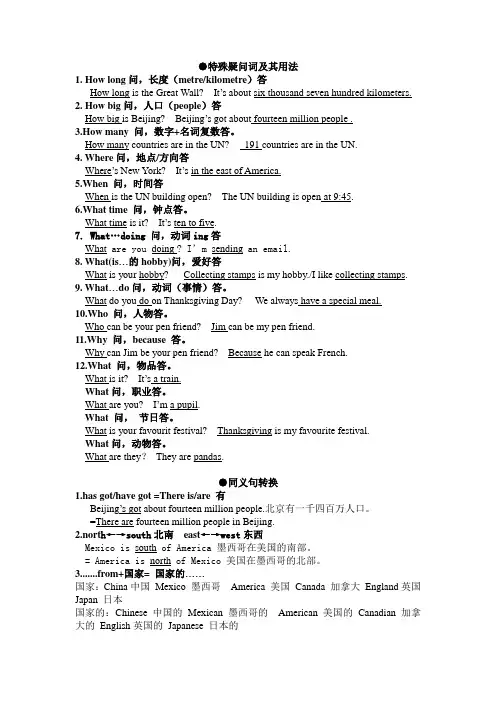
●特殊疑问词及其用法1. How long 问,长度(metre/kilometre)答How long is the Great Wall? It’s about six thousand seven hundred kilometers.2. How big 问,人口(people)答How big is Beijing? Beijing’s got about fourteen million people .3.How many 问,数字+名词复数答。
How many countries are in the UN? 191 countries are in the UN.4. Where问,地点/方向答Where’s New York? It’s in the east of America.5.When 问,时间答When is the UN building open? The UN building is open at 9:45.6.What time 问,钟点答。
What time is it? It’s ten to five.7. What…doing 问,动词ing答What are you doing ? I’m sending an email.8. What(is…的hobby)问,爱好答What is your hobby? Collecting stamps is my hobby./I like collecting stamps. 9. What…do问,动词(事情)答。
What do you do on Thanksgiving Day? We always have a special meal.10.Who 问,人物答。
Who can be your pen friend? Jim can be my pen friend.11.Why 问,because 答。
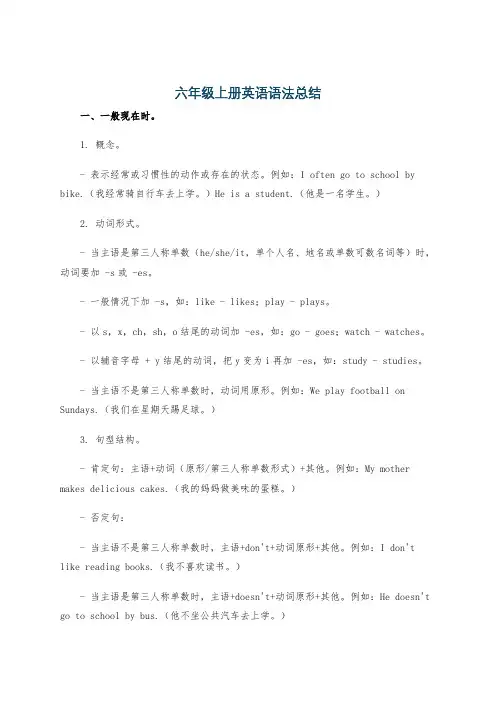
六年级上册英语语法总结一、一般现在时。
1. 概念。
- 表示经常或习惯性的动作或存在的状态。
例如:I often go to school by bike.(我经常骑自行车去上学。
)He is a student.(他是一名学生。
)2. 动词形式。
- 当主语是第三人称单数(he/she/it,单个人名、地名或单数可数名词等)时,动词要加 -s或 -es。
- 一般情况下加 -s,如:like - likes;play - plays。
- 以s,x,ch,sh,o结尾的动词加 -es,如:go - goes;watch - watches。
- 以辅音字母 + y结尾的动词,把y变为i再加 -es,如:study - studies。
- 当主语不是第三人称单数时,动词用原形。
例如:We play football on Sundays.(我们在星期天踢足球。
)3. 句型结构。
- 肯定句:主语+动词(原形/第三人称单数形式)+其他。
例如:My mother makes delicious cakes.(我的妈妈做美味的蛋糕。
)- 否定句:- 当主语不是第三人称单数时,主语+don't+动词原形+其他。
例如:I don't like reading books.(我不喜欢读书。
)- 当主语是第三人称单数时,主语+doesn't+动词原形+其他。
例如:He doesn't go to school by bus.(他不坐公共汽车去上学。
)- 当主语不是第三人称单数时,Do+主语+动词原形+其他?例如:Do you have a pen?(你有一支钢笔吗?)- 当主语是第三人称单数时,Does+主语+动词原形+其他?例如:Does she like music?(她喜欢音乐吗?)二、名词的单复数。
1. 规则变化。
- 一般情况在词尾加 -s,如:book - books;pen - pens。
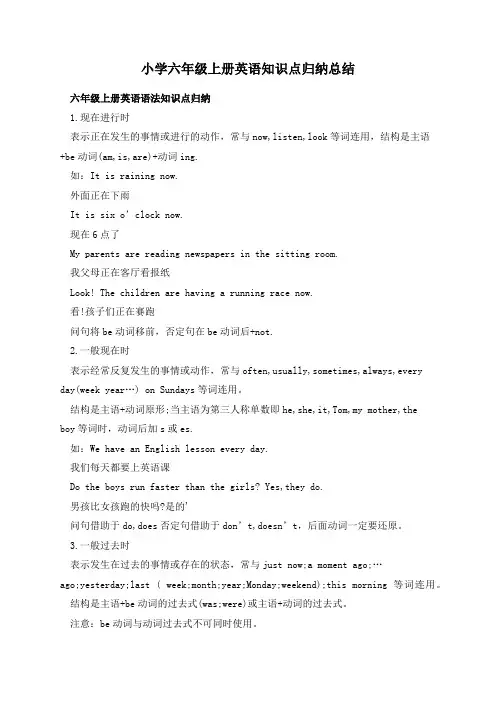
小学六年级上册英语知识点归纳总结六年级上册英语语法知识点归纳1.现在进行时表示正在发生的事情或进行的动作,常与now,listen,look等词连用,结构是主语+be动词(am,is,are)+动词ing.如:It is raining now.外面正在下雨It is six o’clock now.现在6点了My parents are reading newspapers in the sitting room.我父母正在客厅看报纸Look! The children are having a running race now.看!孩子们正在赛跑问句将be动词移前,否定句在be动词后+not.2.一般现在时表示经常反复发生的事情或动作,常与often,usually,sometimes,always,every day(week year…) on Sundays等词连用。
结构是主语+动词原形;当主语为第三人称单数即he,she,it,Tom,my mother,theboy等词时,动词后加s或es.如:We have an English lesson every day.我们每天都要上英语课Do the boys run faster than the girls? Yes,they do.男孩比女孩跑的快吗?是的'问句借助于do,does否定句借助于don’t,doesn’t,后面动词一定要还原。
3.一般过去时表示发生在过去的事情或存在的状态,常与just now;a moment ago;…ago;yesterday;last ( week;month;year;Monday;weekend);this morning等词连用。
结构是主语+be动词的过去式(was;were)或主语+动词的过去式。
注意:be动词与动词过去式不可同时使用。
如:My earphones were on the ground just now.我的耳机刚刚还在呢。
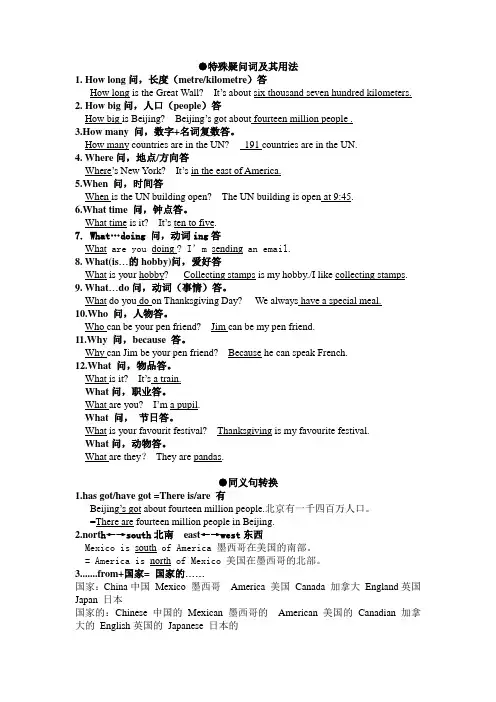
●特殊疑问词及其用法1. How long 问,长度(metre/kilometre)答How long is the Great Wall? It’s about six thousand seven hundred kilometers.2. How big 问,人口(people)答How big is Beijing? Beijing’s got about fourteen million people .3.How many 问,数字+名词复数答。
How many countries are in the UN? 191 countries are in the UN.4. Where问,地点/方向答Where’s New York? It’s in the east of America.5.When 问,时间答When is the UN building open? The UN building is open at 9:45.6.What time 问,钟点答。
What time is it? It’s ten to five.7. What…doing 问,动词ing答What are you doing ? I’m sending an email.8. What(is…的hobby)问,爱好答What is your hobby? Collecting stamps is my hobby./I like collecting stamps. 9. What…do问,动词(事情)答。
What do you do on Thanksgiving Day? We always have a special meal.10.Who 问,人物答。
Who can be your pen friend? Jim can be my pen friend.11.Why 问,because 答。
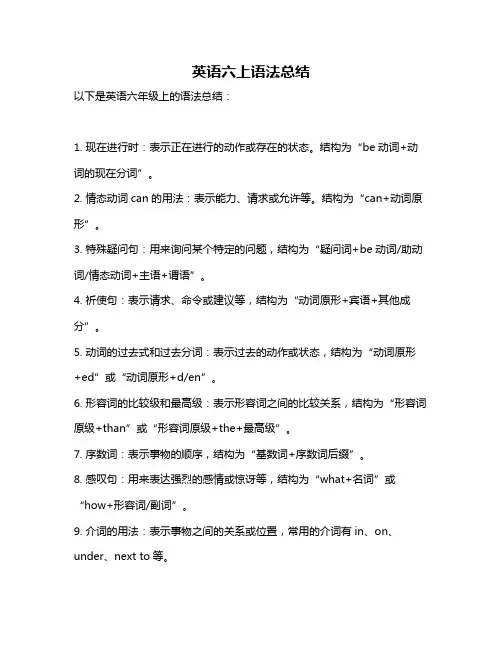
英语六上语法总结
以下是英语六年级上的语法总结:
1. 现在进行时:表示正在进行的动作或存在的状态。
结构为“be动词+动词的现在分词”。
2. 情态动词can的用法:表示能力、请求或允许等。
结构为“can+动词原形”。
3. 特殊疑问句:用来询问某个特定的问题,结构为“疑问词+be动词/助动词/情态动词+主语+谓语”。
4. 祈使句:表示请求、命令或建议等,结构为“动词原形+宾语+其他成分”。
5. 动词的过去式和过去分词:表示过去的动作或状态,结构为“动词原形+ed”或“动词原形+d/en”。
6. 形容词的比较级和最高级:表示形容词之间的比较关系,结构为“形容词原级+than”或“形容词原级+the+最高级”。
7. 序数词:表示事物的顺序,结构为“基数词+序数词后缀”。
8. 感叹句:用来表达强烈的感情或惊讶等,结构为“what+名词”或“how+形容词/副词”。
9. 介词的用法:表示事物之间的关系或位置,常用的介词有in、on、under、next to等。
10. there be句型:表示存在关系,结构为“there be+主语+地点/时间状语”。
以上是英语六年级上的重点语法知识点,需要掌握它们的含义、用法和基本结构。
同时,还需要注意在日常交际中运用这些语法知识,提高自己的英语表达能力。

小学六年级上册英语语法HEN system office room 【HEN16H-HENS2AHENS8Q8-HENH1688】小学六年级上册英语语法What 事件 when 事件 where地点 who谁 why为什么 how 怎样wh疑问词和陈述句是降调。
E--a连 at前后都连读。
单数is复数are,is跟着他她它。
一般情况下加ing:do-doing sing-singing study-studying comfort-comforting以不发音的e、ue结尾的动词去e加ing:dance-dancing like-liking write-writing make-making take-taking以重读闭音节尾的动词且末尾只有一个辅音字母。
最后一个字母不是x的动词应双写最后的字母,再加ing:run-running cut-cutting swim-swimming以ue结尾的动词应变ie为y加ing:die-dying lie-lying以ic结尾的动词应加king:picnic-picnicing traffic-trafficing人称变化5. Excuse(me√ / my / I).6. Are(your√ / you)Miss Li?7. (I√/ My)am Ben.8. (She √/ Her)is my sister.9. Fine , thank (your / you√).10. How old is (he / his√)二、用所给代词的正确形式填空。
1. These are __his____ ( he ) brothers.2. That is ___her____( she ) sister.3. Lily is ___luly’s____ ( Lucy ) sister.4. Tom, this is __mine___ ( me ) cousin, Mary.5. Now ______her parent’s_______(her parent) are in America.6. Those _____child_____ ( child ) are __my___ ( I ) father’s students.7. Do you know ____it is__ ( it ) name?8. Mike and Tom _____be_____ ( be ) friends.9. Thanks for helping ___me_____( I ).10. ___Ann’s___(Ann安)mother is ___we___(we) teacher.三、单项选择。
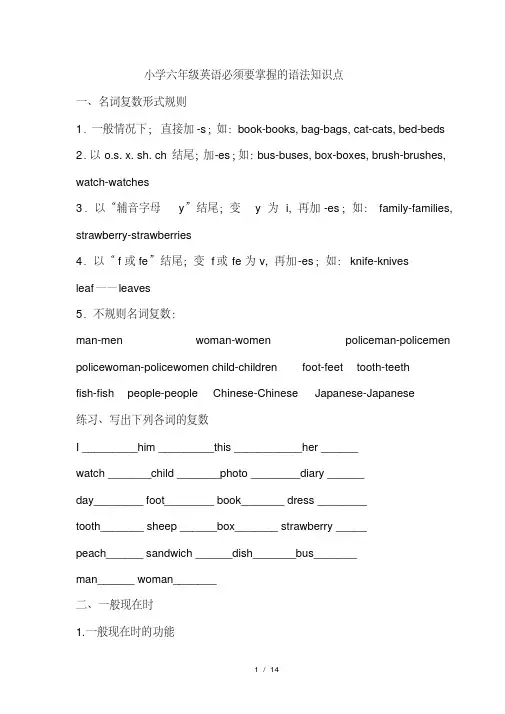
小学六年级英语必须要掌握的语法知识点一、名词复数形式规则1.一般情况下;直接加-s;如:book-books, bag-bags, cat-cats, bed-beds 2.以o.s. x. sh. ch结尾;加-es;如:bus-buses, box-boxes, brush-brushes, watch-watches3.以“辅音字母y”结尾;变y为i, 再加-es;如:family-families, strawberry-strawberries4.以“f或fe”结尾;变f或fe为v, 再加-es;如:knife-knives leaf——leaves5.不规则名词复数:man-men woman-women policeman-policemen policewoman-policewomen child-children foot-feet tooth-teethfish-fish people-people Chinese-Chinese Japanese-Japanese练习、写出下列各词的复数I _________him _________this ___________her ______watch _______child _______photo ________diary ______day________ foot________ book_______ dress ________tooth_______ sheep ______box_______ strawberry _____peach______ sandwich ______dish_______bus_______man______ woman_______二、一般现在时1.一般现在时的功能○1表示事物或人物的特征、状态.如:The sky is blue.天空是蓝色的.○2表示经常性或习惯性的动作.如:I get up at six o’clock every day.我天天六点起床.○3表示客观现实.如:The earth goes around the sun.地球绕着太阳转.2.一般现在时的构成○1肯定句: a. be动词:(有一顺口溜体现了它的用法:我用am ;你用 are ;is 用于他;她;它, 单数is;复数are..)主语+ be(am /is/are)+其他如: I am a boy.我是一个男孩.b.行为动词(实义动词):主语+行为动词+其他[除主语是第三人称单数外;都用动词原形;当主语是第三人称时;则在行为动词词尾加-s或-es.]如:We study English.我们学习英语.She goes to work by bike. 她骑自行车去上班.○2否定句: a.主语+ be(am /is/are) +not + 其他如: I am not a boy.b. 主语+don't/doesn't+行为动词原形+其他如:We don’t study English. She doesn't go to work by bike.○3一般疑问句: a. Be(Am /Is /Are)+ 主语+ 其他?简略回答: (肯) Yes,主语 + be(am /is/are). (否) No,主语 + be(am /is/are)+not.如: Are you a boy?你是一个男孩吗?(肯)Yes,I am. (否) No, I’m not.b. Do/Does+主语+ 其他?简略回答: (肯) Yes,主语+ do/does. (否) No,主语 + don't/doesn't.如: Do you study English? (肯)Yes,we do. (否) No, we don’t. - Does shego to work by bike? - Yes, she does. / No, she doesn't.○4特殊疑问句:特殊疑问词+一般疑问句?如: a. be动词:Who are you?b.行为动词:What do you do? How does she go to work?3.动词三单的变化规则(即“如何从动词原形变为第三人称单数”)○1一般情况下;直接加-s;如:cook-cooks get-gets○2以o.s.x.sh.ch结尾,直接加-es;如:wash-washes, watch-watches, go-goes○3以“辅音字母y”结尾;变y为i, 再加-es;如:study-studies一般现在时用法专练:一、写出下列动词的第三人称单数drink ________ go _______ stay ________ make ________look _________ have_______ pass_______ carry ____________study_______ brush________ do_________ teach_______wash_______二、用括号内动词的适当形式填空.1. He often ________(have) dinner at home.2. Daniel and Tommy _______(be) in Class One.3. We _______(not watch) TV on Monday.4. Nick _______(not go) to the zoo on Sunday.5. ______ they ________(like) the World Cup?6. What _______they often _______(do) on Saturdays?7. _______ your parents _______(read) newspapers every day?8. The girl _______(teach) us English on Sundays.9. She and I ________(take) a walk together every evening.10. There ________(be) some water in the bottle.11. Mike _______(like) cooking.12. They _______(have) the same hobby.13. My aunt _______(look) after her baby carefully.14. You always _______(do) your homework well.m staying in bed.15. I _______(be) ill. I’16. She _______(go) to school from Monday to Friday.17. Liu Tao _______(do) not like PE.18. The child often _______(watch) TV in the evening.19. Su Hai and Su Yang _______(have) eight lessons this term.20. -What day _______(be) it today? -It’s Saturday三、现在进行时1.现在进行时表示现在正在进行或发生的动作;也可表示当前一段时间内的活动或现阶段正在进行的动作.2.现在进行时的构成:be+动词的ing〔现在分词〕形式.肯定句:主语+be动词+动词ing+其他.如:We are studying.否定句:主语+be动词+not+动词ing+其他.如:We aren’t studying.一般疑问句:Be动词+主语+动词ing+其他.如:Are you studying?肯定回答:Yes+主语+be动词.如:Yes,we are.否定回答:No+主语+be动词+not.如:No,we aren’t.;但是am not在;are not可以缩写成aren’t(注:is not可以缩写成isn‘t现代英语中不可以缩写.)特殊疑问句:特殊疑问词+一般疑问句?如:What are you doing?现在分词的变化规则1.一般情况下;直接加ing;如:cook-cooking think---thinking2.以不发音的字母e结尾的单词,去掉字母e;再加ing 如:make-making have---having3.以重读闭音节(重读闭音节即两个辅音中间夹一个元音并且重读的音节)结尾;呈现“辅;元;辅”结构的动词;双写末尾的辅音字母;再加ing 如: stop---stopping sit---sitting run---running4 以ie结尾的动词;把ie改为y ;再加ing die---dying lie---lying现在进行时专项练习:一、写出下列动词的现在分词:play________ run__________ swim _________make__________go_________ like________ write________ study__________read________ have_________ sing ________ dance_________put_________ see________ buy _________ love____________stop_________ sit ________ begin________ shop___________二、用所给的动词的正确形式填空:1.The boy __________________ ( draw)a picture now.2. Listen .Some girls _______________ ( sing)in the classroom .3. My mother _________________ ( cook )some nice food now.4. What _____ you ______ ( do ) now?5. Look . They _______________( have) an English lesson .6.They ____________(not ,water) the flowers now.7.Look! the girls ________________(dance )in the classroom .8.What is our granddaughter doing? She _________(listen ) to music.ow. We _____________(have)supper now9. It’s 5 o’clock n10.______Helen____________(wash )clothes? Yes ,she is .四、一般将来时一、概念:表示将要发生的动作或存在的状态及打算、计划或预备做某事.句中一般有以下时间状语:tomorrow, next day(week, month, year…),soon, the day after tomorrow(后天)等.二、基本结构:肯定句: a. 主语+shall/will+do+其他.(will可用于所有人称;shall只用于第一人称I和we) 如: I will go swimming tomorrow.b. 主语+ be going to + do+其他.(注意:be 动词要与主语的人称和数一致)如:I am going to go swimming tomorrow.否定句:a. 主语+shall/will+not+do(will not 可缩写成won’t)b. 主语+ be+ not+ going to +do 如:I won’t go swimming tomorrow. I am not going to go swimming tomorrow.一般疑问句:a. Shall/Will+主语+ do+其他? b. Be+主语+going to+do+其他?如:Will you go swimming tomorrow? Are you going to go swimmingtomorrow?特殊疑问句:特殊疑问词+一般疑问句?如:What will you go tomorrow? What are you going to do tomorrow?练习填空.1. 我打算明天和朋友去野炊.I_____ _______ _________ have a picnic with my friends.I ________ have a picnic with my friends.2.我们将要学习英语We _____ _______ _________ learn English.We ________ learn English.五、一般过去时1.一般过去时表示过去某个时间发生的动作或存在的状态;常和表示过去的时间状语连用,如:yesterday;yesterday morning;yesterday afternoon;yesterday evening;the day before yesterday(前天);last night;last week;last month; last year等. 一般过去时也表示过去经常或反复发生的动作.2.一般过去式的基本结构:Be动词在一般过去时中的变化:⑴am 和is在一般过去时中变为was.(was not=wasn’t)⑵are在一般过去时中变为were.(were not=weren’t)○1肯定句:主语+动词过去式+其他.如:I was in Shanghai last month.上个月我在上海.We went to Shanghai last month.我们上个月去了上海.○2否定句:a主语+wasn’t/weren’t+其他.如: I wasn’t in Shanghai last month.b. 主语+didn’t+动词原形+其他.(did + not = didn't)如:We didn’t go to Shanghai last month.○3一般疑问句: a.Was/Were+主语+其他?如:Were you in Shanghai last month?b. Did+主语+动词原形+其他?如:Did you go to Shanghai last month? ○4特殊疑问句:特殊疑问词+一般疑问句?如:Where were you last month? Where did you go last month?动词过去式变化规则:1.一般情况下;在动词原形后面加-ed;如:look→looked play→played start→started visit→visited2.以不发音e结尾的动词;在词尾直接加-d;如: live→lived use→used 3.以“辅音字母+ y”结尾的动词;先将 y 改为i ,再加–ed;如: study →studied, try→tried fly→flied4.以重读闭音节(即辅音+元音+辅音)或r音节结尾;末尾只有一个辅音字母的动词;要先双写这个辅音字母后;再加–ed;如: stop→stopped plan→planned5.不规则动词过去式:练习一、写出下列动词的过去式is/am_________ plant________ are ________drink_________ play_______ go________ make ________does_________ dance________ worry________ ask _____taste_________ eat__________ put ______kick_________ pass_______ do ________练习二、用be动词的适当形式填空1. I _______ at school just now.2. He ________ at the camp last week.3. We ________ students two years ago.4. They ________ on the farm a moment ago.5. Yang Ling ________ eleven years old last year.6. There ________ an apple on the plate yesterday.7. There ________ some milk in the fridge on Sunday.8. The mobile phone _______ on the sofa yesterday evening.练习三、用所给动词的适当形式填空1. I ______ (watch) a cartoon on Saturday.2. Her father _______ (read) a newspaper last night.3. We _________ to zoo yesterday, we _____ to the park. (go)4. ______ you _______ (visit) your relatives last Spring Festival?5. ______ he _______ (fly) a kite on Sunday? Yes, he ______.6. Gao Shan _______ (pull) up carrots last National Day holiday.7. I ____________ (sweep) the floor yesterday, but my mother ______.8. What ______ she _______ (find) in the garden last morning? She__________ (find) a beautiful butterfly.六、人称代词和物主代词第一人称第二人称第三人称单数复数单数复数单数复数人称代词主格I we you you she he it they 宾格me us you you her him it them物主代词形容词性my our your your her his its their 名词mine ours yours yours hers his its theirs人称代词指代人或物;在句中作主语或宾语;所以有主格和宾格.宾格代词用于替代处于宾语位置上的名词;可以用作直接宾语和间接宾语. 如:I am a student. (I 主语) Please help me. (me 直接宾语) Give me a book. (me 间接宾语)物主代词是表示所有关系的一种代词;亦称所有格代词.物主代词有两种形式:形容词性物主代词和名词性物主代词.形容词性物主代词为限定词;放在名词或名词短语前作定语.如:This is my book.名词性物主代词起名词的作用;后面不可以再接名词.在句子中可以作主语、宾语或表语.如: Your pen is red. Mine is black.你的钢笔是红色的,我的是黑色的.He didn’t use his ink. He used mine.他没有用他自己的墨水;他用了我的.习题一、用所给词的适当形式填空1. That is not _________ kite. That kite is very small, but _________ isvery big. ( I )2. The dress is _________. Give it to _________. ( she )3. Is this _________ watch? (you) No, it’s not _________ . ( I )4. _________ is my brother. _________ name is Jack. Look! Those stamps are _________. ( he )二、用am, is, are 填空1. I ______ a boy. ______ you a boy? No, I _____ not.2. The girl______ Jack's sister.3. The dog _______ tall and fat.4. The man with big eyes _______ a teacher.5. ______ your brother in the classroom?6. Where _____ your mother? She ______ at home.7. How _______ your father?8. Mike and Liu Tao ______ at school.9. Whose dress ______ this?10. Whose socks ______ they?七、形容词、副词的比较级和最高级(一)构成规则1.一般单音节词和少数以-er;-ow结尾的双音节词;比较级在后面加-er;最高级在后面加-est(1)单音节词如:small→smaller→smallest short→shorter→shortest (2)双音节词如:clever→cleverer→cleverest narrow→narrower→narrowest2.以不发音e结尾的单音节词;比较在原级后加-r;最高级在原级后加-st 如:large→larger→largest nice→nicer→nicest3.在重读闭音节(即:辅音+元音+辅音)中;先双写末尾的辅音字母;比较级加-er;最高级加-est;如:big→bigger→biggest hot→hotter→hottest fat→fatter→fattest4.以“辅音字母+y”结尾的双音节词;把y改为i;比较级加-er;最高级加-est如:easy→easier→easiest heavy→heavier→heaviest busy→busier→busiest happy→happier→happiest5.其他双音节词和多音节词;比较级在前面加more;最高级在前面加most如:beautiful→more beautiful→most beautiful different→more different→most different easily→more easily→most easily注意:(1)形容词最高级前通常必须用定冠词 the;副词最高级前可不用. 如: The Sahara is the biggest desert in the world.(2)形容词most前面没有the;不表示最高级的含义;只表示"非常". It is a most important problem. =It is a very important problem.6.有少数形容词、副词的比较级和最高级是不规则的;必须熟记. 如:good→better→best well→better→best bad→worse→worst ill→worse→worst old→older/elder→oldest/eldest many/much→more→most little→less→least far →further/farther→ furthest/farthest(二)形容词、副词的比较级和最高级的用法1.“A + be +形容词比较级 + than + B”意思为“A比B更,,”.如:This tree is taller than that one. 这棵树比那棵树高.注意:①在含有连词than的比较级中;前后的比较对象必须是同一范畴;即同类事物之间的比较.②在比较级前面使用much;表示程度程度“强得多”.如:A watermelon is much bigger than an apple.③ very, quite一般只能修饰原级;不能修饰比较级.2.“比较级 + and + 比较级”或“more and more +原级”表示“越来越,,”如:It is getting cooler and cooler. 天气越来越凉爽.3.在含有or的选择疑问句中;如果有两者供选择;前面的形容词要用比较级形式.如:Who is taller,Tim or Tom? 谁更高;Tim还是Tom?4. “the +比较级..., the+比较级”;表示“越...越...”.如: The sooner;the better. 越快越好.习题一、出下列形容词、副词的原级;比较级;最高级small→→→fatter→hot→________ →________ thin→________→ _________heavy→________ →________ bad→________→ _________习题二、用适当形式填空:1. Bob is ________ ( young ) than Fred but __________ (tall) than Fred2. Yingtian is not as ___________ (tall) asYongxian.3. Almost all the students' faces are the same but Li Deming looks ____ ___ (fat) than before .4. Which is _________ (heavy), a hen or a chicken?5.-- How _________ (tall) is Sally?-- She' s 1.55 metres ________ (tall). What about Xiaoling? -- She' s only 1.40 metres ______ (tall). She is much _______(short) than Sally. She is also the _______ (short)girlin theclass.。
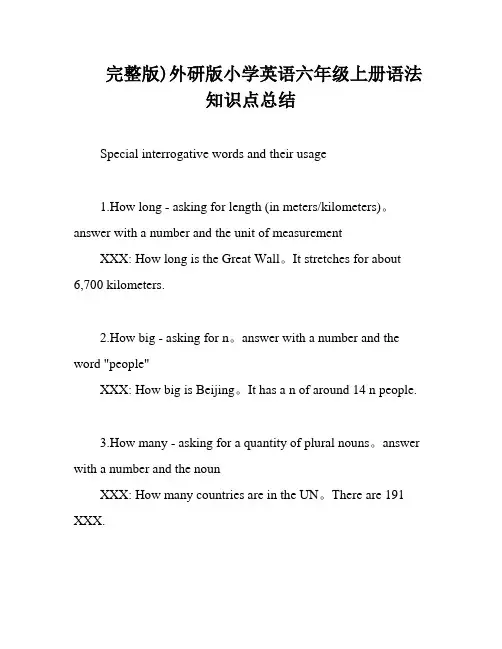
完整版)外研版小学英语六年级上册语法知识点总结Special interrogative words and their usage1.How long - asking for length (in meters/kilometers)。
answer with a number and the unit of measurementXXX: How long is the Great Wall。
It stretches for about 6,700 kilometers.2.How big - asking for n。
answer with a number and the word "people"XXX: How big is Beijing。
It has a n of around 14 n people.3.How many - asking for a quantity of plural nouns。
answer with a number and the nounXXX: How many countries are in the UN。
There are 191 XXX.4.Where - asking for a n or n。
answer with a specific place or nXXX: Where is New York。
It is XXX America.5.When - asking for a specific time。
answer with a time or a time rangeXXX: When is the UN building open。
It opens at 9:45.6.What time - asking for the current time。
answer with the timeXXX: What time is it。
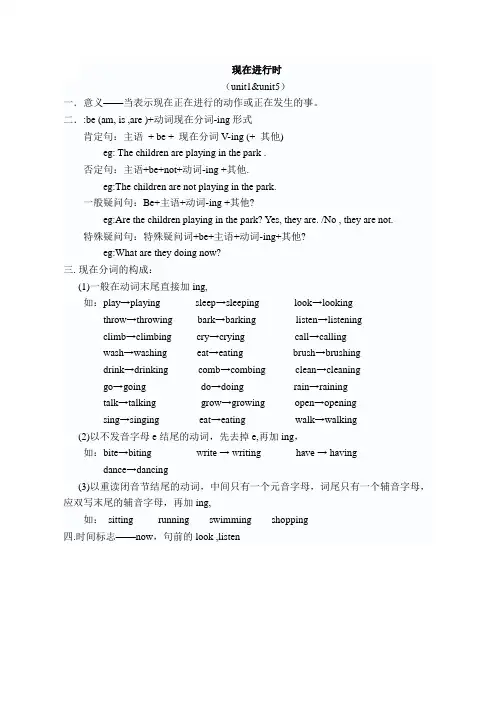
现在进行时(unit1&unit5)一.意义——当表示现在正在进行的动作或正在发生的事。
二.:be (am, is ,are )+动词现在分词-ing形式肯定句:主语+ be + 现在分词V-ing (+ 其他)eg: The children are playing in the park .否定句:主语+be+not+动词-ing +其他.eg:The children are not playing in the park.一般疑问句:Be+主语+动词-ing +其他?eg:Are the children playing in the park? Yes, they are. /No , they are not.特殊疑问句:特殊疑问词+be+主语+动词-ing+其他?eg:What are they doing now?三.现在分词的构成:(1)一般在动词末尾直接加ing,如:play→playing sleep→sleeping look→lookingthrow→throwing bark→barking listen→listeningclimb→climbing cry→crying call→callingwash→washing eat→eating brush→brushingdrink→drinking comb→combing clean→cleaninggo→going do→doing rain→rainingtalk→talking grow→growing open→openingsing→singing eat→eating walk→walking(2)以不发音字母e结尾的动词,先去掉e,再加ing,如:bite→biting write → writing have → havingdance→dancing(3)以重读闭音节结尾的动词,中间只有一个元音字母,词尾只有一个辅音字母,应双写末尾的辅音字母,再加ing,如:sitting running swimming shopping四.时间标志——now,句前的look ,listen现在进行时专项练习:一、写出下列动词的现在分词:play________ run__________ swim ________eat__________ go_________ write________ sit___________ read________ have_________ washsleep ________ look_________ throw________ bark________ listen_________ climb________ bite_______ cry_________ clean call_________ sit ________ shop_________ brush drink comb二、用所给的动词的正确形式填空:1.The children __________________ ( play)in the park now.2. Lingling_______________ ( sit)on a swing now .3. My mother _________________ ( sit )on a bench now.4. What _____ you ______ ( do ) now?5. Look . He _______________( sleep).6.The dog ____________(look) at the children now.7.Look! Mingming ________________(throw )stones at the dog .8.What is our granddaughter doing? She _________(drink ) water.9. It’s 5 o’clock now. We _____________(have)supper now.10.______Helen____________(wash )clothes? Yes ,she is.三、句型转换:1. They are doing housework .(分别改成一般疑问句和否定句)__________________________________________________________________________________________________________________________ 2.The students are cleaning the classroom . ( 改一般疑问句并作肯定和否定回答)__________________________________________________________________________________________________________________________________ 3.I’m playing the football in the playground .(对划线部分进行提问)_________________________________________________________________ 4.Tom is listening . (改为否定句)_________________________________________________________________一般现在时(unit2)一.意义1.表示事物或人物的特征、状态。
完整版)六年级英语上册语法1.play - playing2.sleep - sleeping3.look - looking4.throw - throwing5.bark - barking6.listen - listening7.climb - climbing8.cry - crying9.call - calling10.wash - washing11.eat - eating12.brush - brushing13.drink - drinkingb - combing15.clean - cleaning16.go - going17.do - doing18.rain - raining19.XXX - talking20.grow - growing21.open - opening22.sing - singing23.walk - walking二、改写:1.The children are XXX.2.The children are not playing in the park at the moment.3.Are the children playing in the park right now。
Yes。
they are。
/ No。
they are not.4.What are the children doing now?三、时间标志:Some examples of time markers for the present continuous tense include "now" and "look" or "listen" at the beginning of a sentence.Are they doing housework?They are not doing housework.2.He is XXX(改成现在进行时)XXX.3.XXX(改成否定句)She does not like to swim in the pool.4.We will go to the XXX(改成一般疑问句)Will we go to the park tomorrow?5.I have XXX(改成否定句和过去式)I have not XXX.I XXX.2.当主语为第三人称单数时,助动词为does肯定句:主语+动词原形(+其它)。
六年级上册英语语法知识一、名词单复数形式●规则变化:大多数名词在词尾加-s;以s, x, ch, sh结尾的名词加-es;以o结尾的名词,有的加-s,有的加-es。
●不规则变化:如man-men,child-children, foot-feet,tooth-teeth等。
二、冠词的基本用法●不定冠词a/an表示泛指,定冠词the表示特指。
●a/an用来表示一个事物,而the用来表示特指某个事物。
●第一次提到某人或某物时,用不定冠词a/an;再次提到时,用定冠词the。
三、简单句的基本结构●主语+谓语:例如,I am a student.●主语+谓语+宾语:例如,I love English.●主语+系动词+表语:例如,He is happy.四、介词的用法●表示时间:in表示某个时间范围,on表示在某一天,at表示在具体某一时刻。
●表示地点:in表示在某个范围之内,on表示在某个平面之上,at表示在某个点。
●表示方式:by用于表示手段或方法,with也用于表示手段或方法,but表示转折关系。
五、动词的时态●现在进行时:be+动词ing形式,表示正在进行的动作或状态。
例如,I amstudying English.●过去时:动词ed形式,表示过去的动作或状态。
例如,He studiedEnglish last year.●将来时:will+动词原形,表示将来的动作或状态。
例如,They will visitBeijing next week.六、主谓一致●主语是单数第三人称时,谓语动词要用单数形式;主语是复数时,谓语动词用复数形式。
例如,She is a student./ They are playing football.●主语是其他人称时,谓语动词形式根据实际情况而定。
例如,We arestudying English./ He is playing the guitar.七、形容词的比较级●原级:即形容词本身,表示程度不变。
小学六年级上册英语语法HEN system office room 【HEN16H-HENS2AHENS8Q8-HENH1688】小学六年级上册英语语法What 事件 when 事件 where地点 who谁 why为什么 how 怎样wh疑问词和陈述句是降调。
E--a连 at前后都连读。
单数is复数are,is跟着他她它。
一般情况下加ing:do-doing sing-singing study-studying comfort-comforting以不发音的e、ue结尾的动词去e加ing:dance-dancing like-liking write-writing make-making take-taking以重读闭音节尾的动词且末尾只有一个辅音字母。
最后一个字母不是x的动词应双写最后的字母,再加ing:run-running cut-cutting swim-swimming以ue结尾的动词应变ie为y加ing:die-dying lie-lying以ic结尾的动词应加king:picnic-picnicing traffic-trafficing人称变化5. Excuse(me√ / my / I).6. Are(your√ / you)Miss Li?7. (I√/ My)am Ben.8. (She √/ Her)is my sister.9. Fine , thank (your / you√).10. How old is (he / his√)二、用所给代词的正确形式填空。
1. These are __his____ ( he ) brothers.2. That is ___her____( she ) sister.3. Lily is ___luly’s____ ( Lucy ) sister.4. Tom, this is __mine___ ( me ) cousin, Mary.5. Now ______her parent’s_______(her parent) are in America.6. Those _____child_____ ( child ) are __my___ ( I ) father’s students.7. Do you know ____it is__ ( it ) name?8. Mike and Tom _____be_____ ( be ) friends.9. Thanks for helping ___me_____( I ).10. ___Ann’s___(Ann安)mother is ___we___(we) teacher.三、单项选择。
By一、人称代词二、指示代词四、不定代词一、词类:1、动词:行为动词、be动词、情态动词。
(1)行为动词原形、+s/es、+ed、+ing,具体判断方法如下:(2)be动词a、Am--was Is --was Are--were 口诀:我用am, 你用are, is用在他她它,所有复数全用are。
b、肯定和否定句I am (not) from London. He /She is(not) a teacher. My hair is(not) long. Hereyes are(not) small.c、一般疑问句Am I …? Yes, you are. No, you aren’t. Are you/they…? Yes,we/ they are.No,we/ they aren’t. Is the cat fat? Yes, it is. No, it isn’t.is、am、are为一类,一般用于一般现在时、现在进行时和一般将来时中。
was和were为另一类,一般用于一般过去时。
(3)情态动词can、must、should、would、may。
情态动词后动词总是用原形。
(不受其他任何条件影响)2、名词这里强调两点:不可数名词都默认为单数,所以总是用is或者was。
如何加后缀:a.一般情况下,直接加-s,如:book-books, bag-bags, cat-cats, bed-bedsb.以s. x. sh. ch结尾,加-es,如:bus-buses, box-boxes, brush-brushes, watch-watchesc.以“辅音字母+y”结尾,变y为i, 再加-es,如:family-families, strawberry-strawberries d.以“f或fe”结尾,变f或fe为v, 再加-es,如:knife-knivese.不规则名词复数:man-men, woman-women, policeman-policemen, policewoman-policewomen,mouse-mice child-children foot-feet ,.tooth-teeth fish-fish, people-people,Chinese-Chinese, Japanese-Japanese3、形容词(包括副词)形容词表示某一事物或的特征,副词表示某一动作的特征。
外研版英语六年级(上册)语法知识点详解外研版英语六年级(上册)语法知识点详解本文档旨在详细解释外研版英语六年级(上册)中的语法知识点。
以下是一些重要的语法知识点:1. 一般现在时- 用法:表示经常性、惯性的动作或事实- 结构:主语 + 动词原形(第三人称单数加s)- 示例:I play tennis every Sunday.(我每个星期天打网球。
)2. 一般过去时- 用法:表示过去发生的动作或状态- 结构:主语 + 动词过去式- 示例:She watched a movie last night.(她昨晚看了一部电影。
)3. 一般将来时- 用法:表示将来发生的动作或状态- 结构:主语 + will + 动词原形- 示例:I will go to Beijing next week.(下周我将去北京。
)4. 现在进行时- 用法:表示现在正在进行的动作- 结构:主语 + am/is/are + 动词ing- 示例:They are playing soccer in the park.(他们正在公园踢足球。
)5. 物主代词- 用法:表示所属关系或归属- 结构:my, your, his, her, its, our, their- 示例:This is my book.(这是我的书。
)6. 一般疑问句- 用法:用于提问- 结构:助动词/系动词/情态动词 + 主语 + 动词原形?- 示例:Do you like ice cream?(你喜欢冰淇淋吗?)7. 否定句- 用法:用于否定- 结构:主语 + do/does/did + not + 动词原形- 示例:She does not speak French.(她不会说法语。
)请注意,以上只是一部分语法知识点的概述。
在研究过程中,建议详细阅读教材并做练,以更好地掌握这些语法知识点。
祝您研究进步!。
六年级上册英语语法知识点以下是六年级上册英语的一些主要语法知识点:1. 现在进行时:表示正在进行的动作或存在的状态。
结构为“be动词+动词ing”。
例如,“I am watching TV.”2. 形容词的比较级:表示比较关系。
规则变化为“more+原级”,不规则变化需要单独记忆。
例如,“She is more beautiful than me.”3. 频率副词:表示动作发生的频率。
例如,“I usually go to bed at 10 o’clock.”4. 情态动词:表示推测或可能性。
例如,“She may be at home.”5. 宾语从句:在句子中充当宾语的句子。
例如,“I think that she is lying.”6. 一般将来时:表示将来要发生的动作或存在的状态。
结构为“will+动词原形”或“be going to+动词原形”。
例如,“He will come back in a week.”7. 现在完成时:表示过去发生的动作对现在的影响或完成的动作。
结构为“have/has+过去分词”。
例如,“I have finished my homework.”8. 序数词:表示事物的顺序。
例如,“The first day of the week is Monday.”9. 祈使句:表示请求、命令或建议。
例如,“Please close the door.”10. 条件状语从句:表示在某种条件下,主句的动词才可能发生。
例如,“If you study hard, you will pass the exam.”以上只是部分语法知识点,六年级学生还应掌握更多内容。
如有疑问,可咨询英语教师。
小学六年级上册英语语法What 事件when 事件where地点who谁why为什么how怎样wh疑问词和陈述句是降调。
E--a连at前后都连读。
单数is复数are,is跟着他她它。
一般情况下加ing:do-doing sing-singing study-studying comfort-comforting以不发音的e、ue结尾的动词去e加ing:dance-dancing like-liking write-writing make-making take-taking以重读闭音节尾的动词且末尾只有一个辅音字母。
最后一个字母不是x的动词应双写最后的字母,再加ing:run-running cut-cutting swim-swimming以ue结尾的动词应变ie为y加ing:die-dying lie-lying以ic结尾的动词应加king:picnic-picnicing traffic-trafficing人称变化人称代词单数复数人称主格宾格主格宾格第一人称I me we us第二人称you you you youhe him they them第三人称she herit it人称代词主格:作主语,表示谁怎么样了、干什么了。
I am a teacher.You are student.He is a student, too.We/You/They are students.人称代词宾格作宾语,表示动作行为的对象。
Give it to me.Let’s go (let’s =let us)二、物主代词数人称类别单数复数第一人称第二人称第三人称第一人称第二人称第三人称形容词性物主代词my your his her its our your their 名词性物主代词mine yours his hers its ours yours theirs汉语我的你的他的她的它的我们的你们的他(她、它)们的形容词性物主代词(my/your/his/her/its/our/their)+名词而名词性物主代词(mine/yours/his/hers/its/ours/theirs则相单于形容词性物主代词+名词,故其后不必加名词。
如:Is this your book?No,,it isn’t,it’s hers(her book)Jim’s ,Tom’s,Maria’s代词练习一、选出括号中正确的词,在正确的词上打勾。
1. This is(my√ / I)mother.2. Nice to meet (your√ / you).3. (He / His√)name is Mark.4. What’s(she / her)name?5. Excuse(me√ / my / I).6. Are(your√ / you)Miss Li?7. (I√/ My)am Ben.8. (She √/ Her)is my sister.9. Fine , thank (your / you√).10. How old is (he / his√)二、用所给代词的正确形式填空。
1. These are __his____ ( he ) brothers.2. That is ___her____( she ) sister.3. Lily is ___luly’s____ ( Lucy ) sister.4. Tom, this is __mine___ ( me ) cousin, Mary.5. Now ______her parent’s_______(her parent) are in America.6. Those _____child_____ ( child ) are __my___ ( I ) father’s students.7. Do you know ____it is__ ( it ) name?8. Mike and Tom _____be_____ ( be ) friends.9. Thanks for helping ___me_____( I ).10. ___Ann’s___(Ann安)mother is ___we___(we) teacher.三、单项选择。
( c )1. My family ____ a big family. My family ____all here.A. is, isB. are, areC. is, areD. are, is( c )2. This is __________.A. a picture of familyB. a picture of my familyC. a family’s pictureD. a family of my picture(b )3. Let’s __________ go od friends.A. beB. areC. isD. am( b )4. Is she your aunt? Yes, __________.A. she’sB. her isC. she isD. he is( a )5. Are __________ coats yours?Yes, they are .A. theyB. theseC. thisD. there()6. Is that __________ uncle? No, it isn’tA. heB. sheC. herD. hers()7. Mrs. Green is __________ grandmother.A. Jim and KateB. Jim and Kate’sC. Jim’s and Kate’sD. Jim and Kates’()8. Do you know the name _____Mr. Green’s son?A. inB. ofC. onD. or()9. __________ the great photo of your family.A. thank forB. Thanks forC. Thank forD. thanks for()10. Are those your friends? __________.A. Yes, they’reB. No, they areC. Yes, they areD. Yes, those are一般过去时1 概念:表示发生在过去的事情或则动作。
2 句子重点事件标志词汇:yesterday,last month/year/weekend,just now,five years ago,……轻松地搞定语法轻松地搞定语法是完全可以做到的。
因为我们只要弄懂四类词的用法,语法方面基本上就不会有太大问题了。
这四类词分别是:名词、动词、形容词和副词。
一、为什么说这四类词很重要?“名词、动词、形容词和副词”又被称为“四大词性”,是贯穿英语语法的一条重要的线索。
可以这样说,英语语法就是解答以下三个问题。
<imgsrc="https:///50/v2-105c248058882c4ae37848bc78b22814_hd.png" data-rawwidth="752" data-rawheight="184" class="origin_image zh-lightbox-thumb" width="752"data-original="https:///v2-105c248058882c4ae3 7848bc78b22814_r.png">前两个问题是问题3的铺垫,所以我们先简单了解一下这四类词性的用法:•名词是人、事物或是抽象概念的名称;•动词用来表示人或事物的动作;•形容词和副词是修饰语,用来给被修饰的成分添加附加信息;•形容词用来修饰名词和代词;•而副词的用法和形容词正好相反,副词是用来修饰除名词和代词外的其它结构,因此,副词能够修饰动词、形容词、副词、短语、句子等。
下图是“名词、动词、形容词和副词”与“主谓宾定状补表”七类句子成分的关系:<imgsrc="https:///50/v2-af5575597e8e94a98a2dc0784 cb11945_hd.png" data-rawwidth="358" data-rawheight="160" class="content_image" width="358">即,名词可以作主语、宾语、表语和补语;形容词可以作定语、表语和补语;副词只可以作状语;动词只可以作谓语。
请大家先记住这个结论,因为接下来它会发挥很大的作用。
接下来分析问题3(即哪些结构可以当作名词、动词、形容词和副词使用),这个问题才是我们建立语法框架的关键,因为英语中绝大部分的句子都是由“四大词性”和“七类辅助结构”(介词短语、三类从句、三类非谓语动词)所组成的。
而我们在应用这七类辅助结构时,事实上是将它们当作四大词性中的一类来使用的,如下列对应表所示:<imgsrc="https:///50/v2-e0109aa0efde084510d213a54 8f585de_hd.png" data-rawwidth="653" data-rawheight="213" class="origin_image zh-lightbox-thumb" width="653"data-original="https:///v2-e0109aa0efde084510 d213a548f585de_r.png">如何使用上面的对应表?用其中的介词短语(“介词+ 名词”被称为介词短语)来举例,如下图红框所示:<imgsrc="https:///50/v2-fe7d0d83390adc7fd5a226932 1da360c_hd.png" data-rawwidth="653" data-rawheight="213" class="origin_image zh-lightbox-thumb" width="653"data-original="https:///v2-fe7d0d83390adc7fd5 a2269321da360c_r.png">由上图可知,介词短语在句子中可以被当做形容词和副词来使用。